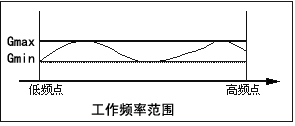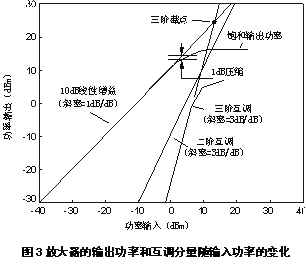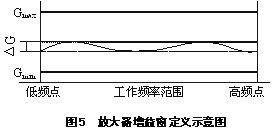Operating frequency range (F):
Refers to the working frequency range where the amplifier meets all levels of indicators. The actual operating frequency range of the amplifier may be greater than the defined operating frequency range.
Power gain (G):
Refers to the ratio of the output power of the amplifier to the input power, the unit is commonly used "dB".
Gain flatness (ΔG):
Refers to the range of amplifier gain change over the entire operating frequency range at a certain temperature. The gain flatness is expressed by the following formula (see Figure 1): 
figure 1
ΔG = ± (Gmax-Gmin) / 2dB
ΔG: gain flatness
Gmax: gain -the maximum amplitude of the frequency sweep curve
Gmin: gain-the minimum value of the amplitude of the frequency sweep curve
Noise figure (NF):
Noise figure refers to the ratio of the signal-to-noise ratio at the input end to the signal-to-noise ratio at the output end of the amplifier .
The noise figure is expressed by the following formula: NF = 10lg (signal-to-noise ratio at input / signal-to-noise ratio at output)
When the noise figure of the amplifier is relatively low (for example, NF <1), the noise figure of the amplifier is usually expressed by the noise temperature (T).
The relationship between noise figure and noise temperature is: T = (NF-1) T0 or NF = T / T0 + 1
T0-absolute temperature (290K)
Conversion table of noise figure and noise temperature (see Figure 2)
1dB compression point output power (P1dB):
The amplifier has a linear dynamic range, within which the output power of the amplifier increases linearly with the input power. This amplifier is called a linear amplifier, and the ratio of these two powers is the power gain G. As the input power continues to increase, the amplifier enters the nonlinear region, and its output power no longer increases linearly with the increase in input power, that is, its output power is lower than the value expected by the small signal gain. Usually the output power value when the gain drops to 1dB lower than the linear gain is defined as the 1dB compression point of the output power, which is expressed by P1dB. (See Figure 3) 
Typically, when the power exceeds P1dB, the gain will quickly drop and reach a maximum or fully saturated output power, which is 3-4dB greater than P1dB.
Third-order intercept point (IP3):
The easiest way to measure the nonlinear characteristics of an amplifier is to measure the power level P1dB at the 1dB compression point. Another popular method is to use two adjacent signals 5 to 10 MHz apart. When these two signals with frequencies f1 and f2 are added to an amplifier, the output of the amplifier not only contains the two signals, but also Contains the intermodulation component (IM) whose frequency is mf1 + nf2. Here, m + n is called the order of the intermodulation component. At medium saturation levels, the third-order component closest to the pitch frequency is usually the dominant one (see Figure 4). 
Because the third-order terms play a dominant role up to the point where the distortion is very severe, the third-order intercept point (IP3) is commonly used to characterize intermodulation distortion (see Figure 3). The third-order intercept point is an important indicator to describe the linearity of the amplifier. The typical value of the third-order intercept point power is 10-12dB higher than P1dB. IP3 can be obtained by measuring IM3, the calculation formula is:
IP3 = PSCL + IM3 / 2;
PSCL -single carrier power;
If the third-order intermodulation point is known, the spur levels of the fundamental and third-order intermodulation suppression ratio and the third-order intermodulation point can be estimated by the following formula:
Fundamental and third-order intermodulation suppression ratio = 2 [IP3- (PIN + G)]
Third-order intermodulation spurious level = 3 (PIN + G) -2IP3
Input / output standing wave ratio (VSWR):
Microwave amplifiers are usually designed or used in microwave systems with 50Ω impedance. The input / output standing wave indicates how well the amplifier input impedance and output impedance match the system's required impedance (50Ω).
Use the following formula:
VSWR = (1+ | Γ |) / (1- | Γ |);
Where Γ = (Z-Z0) / (Z + Z0)
VSWR: input and output voltage standing wave ratio Γ: reflection coefficient
Z: actual impedance at the input or output of the amplifier
ZO: required system impedance
Working voltage / current:
Refers to the power supply voltage that the amplifier needs to supply and the current value that the amplifier requires to supply during operation.
Definition of amplifier gain window:
In this product manual, the gain of the amplifier is defined using the method of gain window definition (excluding narrowband power amplifiers). The definition method of the gain window is to clearly define the allowable fluctuation and variation range of the amplifier's gain according to three gain indicators, such as the maximum gain allowed by the amplifier (Gmax), the minimum gain allowed by the amplifier (Gmin), and the amplifier gain fluctuation (ΔG) (See Figure 5):


Follow WeChat

Download Audiophile APP

Follow the audiophile class
related suggestion